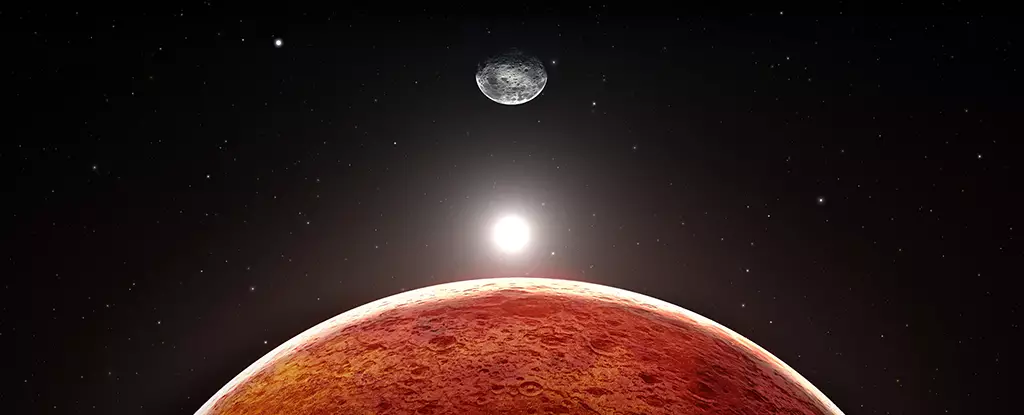

Mars, renowned for its striking reddish hue and captivating topography, has been a focal point of astronomical inquiry for centuries. Despite extensive exploration and numerous studies, its unusual shape and geological features continue to baffle scientists. A new hypothesis proposed by astronomer Michael Efroimsky from the US Naval Observatory puts forward a compelling theory that a long-lost moon, tentatively named Nerio, may have significantly influenced Mars’ development and appearance. This article will explore the implications of this hypothesis and the broader impact it could have on our understanding of planetary formation.
One of the most striking characteristics of Mars is its triaxial shape. Unlike any other planet in our Solar System, Mars exhibits significant variation in curvature along its three axes, resembling a distorted ellipsoid. This peculiarity raises important questions about the planet’s evolution. Traditional models of planetary formation suggest a more spherical shape; thus, the pronounced triaxiality of Mars has puzzled planetary scientists for decades.
Efroimsky’s hypothesis posits that the gravitational influence of a substantial moon orbiting early Mars could account for this unique shape. By suggesting that a moon—a third the size of Earth’s moon—might have orbited Mars, Efroimsky injects an interesting layer into the discourse on planetary geology. According to his calculations, the presence of this moon, Nerio, might have elongated Mars during its formative years when the planet was still molten and plastic, influencing its ultimate shape.
Nerio’s influence may not have stopped with the planet’s shape. The gravitational forces exerted by a massive moon could have catalyzed significant geological activity on Mars, including the rise of its prominent features. For instance, the Tharsis volcanic region, the Valles Marineris canyon system, and Olympus Mons, the tallest volcano in the Solar System, could all trace their origins back to this hypothetical moon’s gravitational pull.
Efroimsky elaborates that as Mars became tidally locked to Nerio, with one hemisphere permanently facing the moon, the variations in gravitational pull would have triggered pronounced geological phenomena. The “seed triaxiality” established by Nerio might have induced convection currents in the Martian mantle, leading to the acceleration of tectonic and volcanic activity, further shaping the planet’s topography.
The proposition that a moon of this nature once existed around Mars introduces exciting yet complex questions about the planet’s history. Perhaps this moon met a catastrophic end during the Late Heavy Bombardment—a tumultuous period marked by high rates of asteroid impacts across the inner Solar System—resulting in the formation of Mars’s current, smaller moons, Phobos and Deimos, which are seen as remnants of a larger celestial body.
While Nerio’s existence is largely speculative, Efroimsky’s model positions it as a crucial player in Mars’s narrative. However, there remain significant gaps in this theory. Currently, there is no concrete evidence supporting the existence of a moon of Nerio’s proposed size. The scenarios regarding its potential destruction or loss to orbit invite further investigation and discussion about Mars’ geological past.
As we continue to explore Mars and enhance our understanding of its history, the study of hypothetical moons like Nerio could open new avenues for research. Future missions aimed at uncovering subsurface geological features and conducting more extensive analyses of Mars’s topography could provide vital insights into its past.
Whether or not Nerio ever existed, examining its proposed role reinforces the notion that planetary evolution is profoundly influenced by celestial mechanics. As scientists investigate the dynamics of planetary systems, such speculations illuminate not only Mars’ peculiar shape but also the intricate dance of gravitational forces that governs the fate of planets throughout the cosmos.
In sum, the idea of a long-lost moon could potentially reshape the narrative of Mars’s geological evolution and offers a fascinating glimpse into the intricate complexities of planetary science. The mysteries of the red planet may not only reflect its past but could also inform our understanding of potential celestial relationships in the broader universe.
A groundbreaking discovery by scientists at the University of Manchester is poised to reshape the…
In an era marked by rapid ecological change, the quest for understanding environmental pollutants like…
The meteoric rise of artificial intelligence (AI) technologies is not without significant implications on our…
The landscape of quantum computing is on the verge of transformative progress, fueled by groundbreaking…
Schizophrenia is not merely a mental health issue; it is a multifaceted condition that wreaks…
Recent scientific research has illuminated the intricate web that ties our dietary choices to the…
This website uses cookies.